In this article we explore the relation between global network visibility as seen by the Routing Information Service (RIS) and the length of announced prefixes.
Introduction
Internet routes are specified for an address prefix. The shorter the prefix, the more general the route. A shorter prefix covers more address space and thus a bigger part of the Internet. Very long prefixes cover few addresses and are used for local routing close to the destination address. In general, it is not necessary to distribute very long prefixes to the whole Internet, because a more general, shorter prefix is sufficient to direct packets in the direction of the destination.
In order to limit the growth of the Internet routing table, many operators limit the length of the prefixes they propagate. We were interested to see what the currently prevailing limits are.
The question about how prefix length affects visibility, especially when it comes to IPv6 /48 prefixes, has been asked on multiple occasions. In this article we aim to answer the following question:
Do /48 BGP announcements experience more filtering than /32?
Data Sources
Visibility is calculated based on the routing tables of our RIS peers . RIS is the RIPE NCC's network of 14 routers located at exchange points around the globe. We ignore peers with partial feeds, i.e. those with under 4000 prefixes. IPv4 and IPv6 are considered separately.
On 1 August 2011, the date when the snapshots shown in the graphs below were taken, we had 80 full IPv6 and 110 IPv4 peerings.
All prefixes seen by any of our peers are included in the graphs below, except IPv4 prefixes seen by less than three peers.
Visibility Calculation - Methodology
A prefix's visibility is determined by dividing the number of full peers announcing the prefix to us by the total number of full peers for that IP version. For example, consider the prefix the RIPE NCC was assigned by Surfnet in the past: 2001:610:240::/42 . On 1 August 2011 at 16:00:00 UTC, 53 of our peers announced this prefix, but one of them is a partial peer. At this time, we peer with 80 full peers. Hence the visibility is 52 / 80 = 65% ; only 65% of our peers see the prefix.
Note that low visibility does not necessarily mean low reachability. In the example above, Surfnet also announce the aggregate /32. If the 28 full feed peers that did not see the /42, did see Surfnet's /32, chances are packets were still be able to find their way to RIPE NCC.
Also note that the RIPE NCC is now using prefix 2001:67c:2e8::/48 that was directly assigned according the procedure described in the document ripe-476 . The visibility for this prefix is 100%.
In most charts below, globally visible prefixes are green and partially-visible prefixes are yellow or red. Prefixes in red are generally internal routes leaked from our peers. The exact percentage of RIS peers seeing this prefix is indicated in the legend.
IPv4 Visibility in August 2011
To begin our investigation, we looked at the IPv4 Internet on 1 August, which shows a better understood graph than IPv6. Each column in the following chart represents all the prefixes with one length.
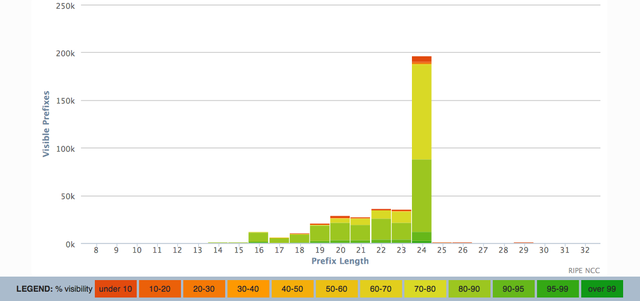
Figure 1: Visibility of IPv4 prefixes
This method allows us to see that most prefixes are /24s. About half are visible by at least 80% of our peers (as indicated by the light green bar in Figure 1). Note that a number of our peers in this calculation do not contain a full table. This contributes to the rather low maximum visibility.
Since /24s make up such a significant portion of all prefixes, it's difficult to compare visibility between prefix lengths. The following chart contains the same data, but the y-axis is scaled independently for each column:

Figure 2:Visibility of IPv4 prefixes, scaled by column
The chart shows that prefixes longer than /24s are not really visible on the Internet, because it is common practice to filter them out. The chart also shows that visibility gradually decreased as the prefixes get longer, i.e. more specific (note the changing green bar for prefix lengths between /14s and /24s). We are not sure why we see this behaviour. If you have an explanation, please share with us in the comments below.
Note: the red /8s are internal routes leaked from AS3303 (Swisscom) and appear because Swisscom peers with RIS at three points.
IPv6 visibility in August 2011
IPv4 shows a fairly obvious and expected pattern. Now that we understand the methodology, let's move onto IPv6. The next graphs are analogous to the IPv4 images shown above, but now for IPv6 prefixes:
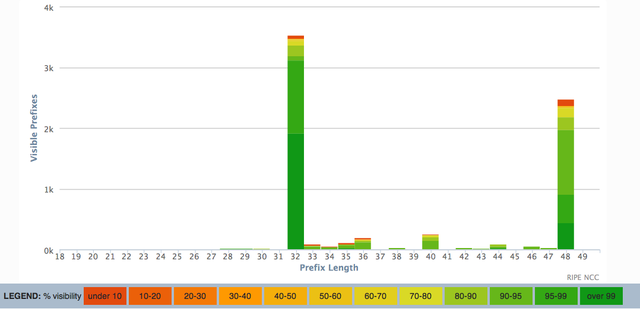
Figure 3: Visibility of IPv6 prefixes
You can see that /32 and /48 make up the huge majority of prefixes, and a significantly higher percentage of prefixes are seen by all our full peers. After independently scaling the y-axis, it becomes clear the trend seen in IPv4 of gradually decreasing visibility is not present in IPv6:

Figure 4: Visibility of IPv6 prefixes, scaled by column
For prefixes longer than a /48, visibility drops dramatically, and the remaining prefix lengths are omitted from the graph. Because /32 and /48 are the most important prefix lengths, we can compare their visibility from a different angle. In the next chart, you can see the visibility of /32s (in blue) and /48s (in red) more precisely: Each point shows how many of the prefixes with that length are visible with what percentage.
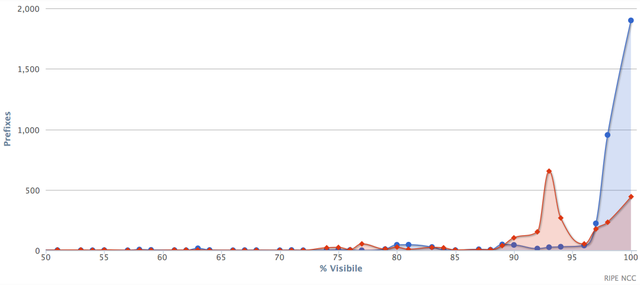
Figure 5: Number of prefixes with each visibility with more precision ( /32 (blue), /48 (red))
As you can see, most /32s are visible by 100% of our peers, but it's clear a large number of /48s are only visible by 93% of our peers.
IPv6 Visibility Over Time
A related question is how visibility is changing over time. In Figure 6 below, you can see the visibility of /32sand /48 prefixes since 2007. The colours represent the same visibility percentages as in the above charts, but only for one prefix length.
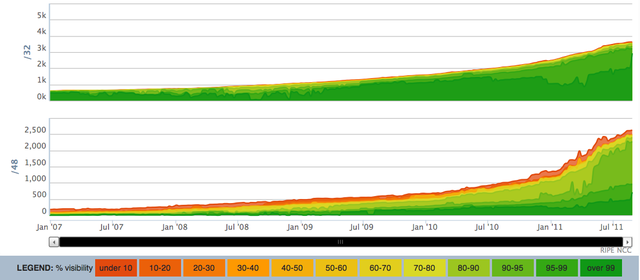
Figure 6:Visibility of /32 and /48 prefixes since 2007
Because we heard that /48s used to be filtered more in the past, but not anymore, we had hoped to see that /48s were becoming as visible as /32s. However, this doesn't appear to the the case. The only clear movement in that direction was around May 2011, when a number of /48s jumped from < 95% to > 95% visibility, which might be related to the preparations for the World IPv6 Day.
In a future article it may be interesting to investigate how low visibility affects reachability and the length of AS paths.
Please let us know your comments below.


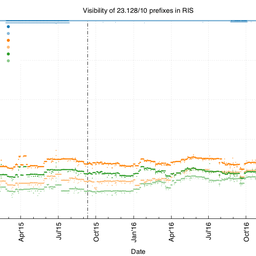


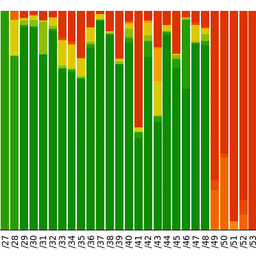
Comments 9
The comments section is closed for articles published more than a year ago. If you'd like to inform us of any issues, please contact us.
Leo Vegoda •
This is an interesting analysis but I do not think it takes account of where the prefixes come from. For instance, I understand that the RIPE NCC's IPv6 PI assignments come from 2001:678::/29 and would not be surprised in /48 prefixes from there have a greater visibility than a /48 from 2a00:::/12, where I think the minimum allocation size is still /32. Does the party of the address space the prefix comes from make any difference?
Devin Bayer •
Hi Leo - that would definitely be an interesting new angle and if we release an update to this study we'll definitely separate out the analysis for PA and PI space.
Paul Freeman •
Are there any plans to revisit these visibility measurements given the accelerated uptake of IPv6 in the last few years?
Mirjam Kühne •
Hi Paul, Thanks for your interest in this work. There is definitely interest in re-running these measurements. Unfortunately we don't have the resources at the moment. We'll try to pick this up again as soon as possible.
Yang Yu •
Now seems to be a good time to redo the test as all RIRs have run of IPv4 address.
Jaganraj •
Is the ip 11.5.5.23/0 is possible or not? If we configure this IP with prefix length 0, will it ping or not? For both IPv4 and IPv6.
Kurt Kayser •
Hello, I wonder if this whole Report would look different today compared to 8 years ago. Maybe there are serious changes in the meantime which would lead to very different results. Regards, Kurt
Mirjam Kühne •
Hi Kurt, We are currently working on an updated version. We will announce it as soon as it is ready. Good to hear that there is interest :-) .
Lefteris Tsintjelis •
Our AS just added IPv6 (/48) and visibility is at 45%!!! That is way bad and not only visibility but also readability has serious issues. This was way bad and really unexpected. I have used IPv6 about 10yrs ago and doesn't seem to have gotten much better at all. Seems like it will take a few decades and a few more RFCs to make it work. Really make me wonder if it Is only RIPE's /48 fully 100% reachable and visible.